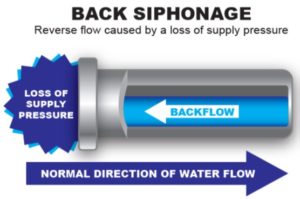What Is There To Know About Backflow Prevention
Backflow is a reversal of the flow of water from its intended flow path. This is usually due to the loss of pressure from the public water supply – backpressure or a back-siphonage.
Water that comes into your home should go in a single direction. Backflow can occur when it does not. Contaminated water can contaminate freshwater when normal water pressure drops abruptly in the system and the flow of supply water reverses, sucking unhealthy water back into your drinking water supply from any source cross-connected to the freshwater system.
Back-Pressure
Back-pressure occurs when the pressure from a private water system is more powerful than the pressure in the city water system. This pressure forces water from a non-potable water source into the supply system of the public water source, and into residences.

Back-Siphonage
Back-siphonage is classified by regular water flow reversal and is caused by a reduction in pressure in the local water supply system in a city. This pulls the water into the public water system from a source that may be tainted or contaminated. It is most often caused by water flow changes due to local firefighting or a water main break.
Cross Connection
A cross-connection is a piping structure that allows the connection of a potable water system to a potential source of waste or contamination. Controlling cross-connections is necessary to prevent a backflow of pollutants to drinking water. Ultimately, backflow has the ability to cause the entire public water supply to be contaminated, posing a risk to anyone using the water.
Cross-connection control is required in boiler systems, cooling systems, fire extinguisher systems, lawn irrigation systems, reclaimed water systems, and swimming pools.
Backflow Preventer
You probably have a backflow preventer already at home. Installing a backflow prevention device in a home’s plumbing system is legally required; backflow is a public health problem. However, you may need to have your current device replaced at some point, and this can only be done by a licensed technician.
External Factors
When backflow occurs it’s rarely due to something you’ve done in your home. The cause of the backflow is a sudden pressure shift: a pressure reduction on the side of the freshwater, or a rise in pressure on the side of the wastewater.
This can happen due to problems in the municipal sewer system, or due to firefighting. You can’t control these events, so to keep your water safe from contamination, you must rely on a properly working backflow preventer.
Get Your Backflow Preventer Tested
There is a need for annual testing of the backflow preventer in a home. This test can only be provided by specially certified technicians to determine whether the backflow preventer is working properly or whether it needs repairs or replacement.
Regular inspection and maintenance are needed to ensure backflow prevention. For inquiries, call Shaul’s at 778-397-4850 to schedule an appointment with us.



One Thought on “What Is There To Know About Backflow Prevention”
Comments are closed.